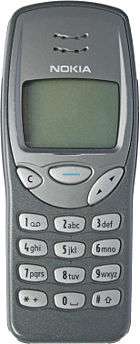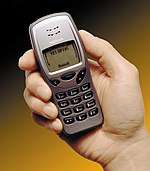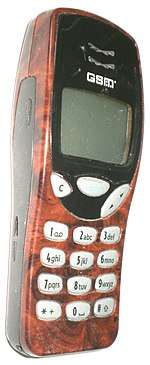Nokia 3210
The Nokia 3210 is a GSM cellular phone, announced by Nokia on 18 March 1999.[3]
 | |
| Manufacturer | Nokia |
|---|---|
| Series | Nokia 3000 series |
| Compatible networks | GSM 900 / 1800 |
| First released | 1999 |
| Units sold | 160 million |
| Predecessor | Nokia 3110 Nokia 5110 |
| Successor | Nokia 3310 Nokia 210 (2019) |
| Related | List of Nokia products |
| Type | Basic phone |
| Form factor | Candy bar |
| Dimensions | 123.8 mm × 50.5 mm × 22.5 mm (4.87 in × 1.99 in × 0.89 in) |
| Mass | 151 g (5.3 oz) |
| Operating system | Series 20 UI[1] |
| CPU | Texas Instruments MAD2PR1 (based on ARM7TDMI) |
| Memory | SIM card only - up to 250 names in phonebook |
| Battery | Removable BML-3 (NiMH) 1250 mAh |
| Data inputs | Alphanumeric keypad |
| Display | 1.5-inch backlit monochrome graphic LCD display 84x48 px, 64 ppi, 5 lines[2] |
| Sound | Monophonic ringtones |
A combination of cutting-edge features such as internal antennas and T9 text entry ensured the 3210 huge commercial success. Much of the phone's success can also be attributed to an advertising campaign aimed predominantly at young people, a first in the mobile phone industry. The inclusion of 3 games, changeable "Xpress-on" covers (as on the previous Nokia 5110), an internal antenna, customisable ringtones and competitive prices led to the handset's huge popularity with those aged 15–25. It was also thinner than previous Nokia models. With 160 million units sold,[4][5] the 3210 is one of the most popular and successful phones in history. It is considered one of the most significant handsets Nokia ever developed.[6]
Design

The Nokia 3210 has a total weight of 151 g. The handset measures 123.8 × 50.5 × 22.5 mm and features customisable fascias which clip on. It was the first mass market phone with an internal antenna, after the feature had been introduced by Nokia on the luxury phone Nokia 8810 in 1998. The 3210 was designed by Alastair Curtis in Nokia's Los Angeles Design Center.[7] The development was led by Frank Nuovo, who had designed the sleek and curvy Nokia 8110 in 1996. The team wanted to create an "expressive" and personalisable handset beyond the usual business-oriented mobile phone market, inspired by the Casio G-Shock and Sony Walkman designs. The phone thus became highly influential.[8]
Notable features
- Three games came preinstalled: Snake, Memory (pairs-memory game) and Rotation. The addition of such games encouraged high sales within a youth market which was enlarging at a very fast rate. Some versions of the 3210 included the "hidden" games React and Logic. They were activated by special software using a data cable.
- The 3210 was one of the first mobile phones to feature an internal antenna, distinguishing the handset from others which featured external antennae. Reception, although poorer than that of its predecessor, the 3110, was still very good.
- The 3210 was the first device that came preloaded with Nokia's Composer software, which allowed users to manually 'compose' monotone ringtones.
- Picture messages sent via the SMS texting service were implemented in the handset, allowing users to send preinstalled pictures to one another. These included a "Happy Birthday" picture amongst others.
- The phone allowed creating single-channel ringtones via internal software. It was possible to send the ringtones to another Nokia phone.
- The handset was competitively priced and aimed specifically at teenagers and young professionals. This was at a time when few young people had access to a mobile phone, being generally identified with older professionals and business people.
- The 3210 was originally designed with a vibrate alert function. Nokia decided not to implement this feature on some handsets within certain jurisdictions. A few months after its UK release, some mobile phone repair shops offered customers a handset upgrade to the vibrate function for a small fee.
Handset specifications

- Standby time (h): 55–260
- Talk time (min): 180–270
- Charge time (h): 4
- Ringtone composer
- Dual band: yes
- Vibrating alert (optional)
- Speed dialing
- 3 games
- Internal antenna
- Green backlight
- Interchangeable fascias
See also
References
| Wikimedia Commons has media related to Nokia 3210. |
- https://touchit.sk/zaspominajte-si-s-touchit-legenda-menom-nokia-3310/63706
- "Nokia 3210 - phone from the past: description, characteristics and advantages". Henry engineering. Retrieved 13 September 2019.
- "Nokia unveils a mobile phone for ultimate convenience and personalization". Nokia. Archived from the original on 14 July 2014. Retrieved 7 July 2014.
- "Nokia's best-selling phones: in pictures". The Telegraph. Retrieved 31 October 2012.
- Walker, Tim (17 November 2011). "Nokia: The giant with its fingers crossed". The Independent. Retrieved 31 October 2012.
- https://www.wired.co.uk/article/the-nokia-3210-was-the-greatest-phone-ever-made
- "Alastair Curtis Bio" (PDF). Nokia Press. Archived from the original (PDF) on 13 December 2013. Retrieved 3 June 2014.
- http://www.slate.com/articles/technology/the_next_20/2016/09/the_development_of_the_nokia_3210_the_cellphone_that_started_the_mobile.html